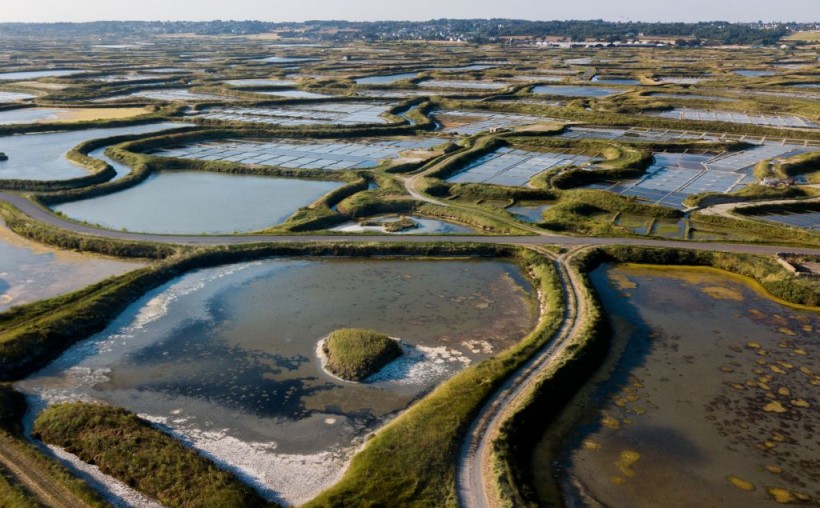The salt marshes of Cape Cod are both iconic and significant. These lovely low-lying wetlands are among the most biologically productive ecosystems on the planet.
They play a significant role in nitrogen cycling, serve as carbon sinks, protect coastal development from storm surges, and serve as critical habitats and nurseries for many fish, shellfish, and coastal birds.
An Ecosystem Engineer
 (Photo : LOIC VENANCE/AFP via Getty Images)
(Photo : LOIC VENANCE/AFP via Getty Images)

According to new Marine Biological Laboratory (MBL) research, more than 90% of the world's salt marshes are likely to be underwater by the end of the century, as per Phys.org.
The study appears in the journal Science of the Total Environment.
The findings are the result of a 50-year study conducted in Great Sippewissett Marsh in Falmouth, Massachusetts.
Scientists from the MBL Ecosystems Center have been mapping vegetative cover in experimental plots in this marsh since 1971 to see if increased nitrogen in the environment would affect marsh grass species.
Because of the length of the study, they were also able to detect the effects of climate change on the ecosystem, particularly those caused by accelerating sea level rise.
The researchers discovered that increased nitrogen favored higher levels of vegetation and marsh surface accretion, but that no matter how much nitrogen they applied to the marsh, these ecosystems will not be able to outpace submergence from global sea level rise.
Salt marshes are gently sloping ecosystems with very specific preferences for the elevations at which they can grow.
Different species grow at higher elevations (high marsh) versus lower elevations (low marsh) and respond differently to changes in nitrogen supply.
The grasses can migrate to their preferred elevation if a change occurs slowly enough.
Cordgrass (Spartina alterniflora) thrived in the low marsh as scientists increased the nitrogen supply.
The abundance of marsh hay (Spartina patens) in the experimental plots decreased with sea level rise among high marsh species.
Saltgrass (Distichlis spicata) increased with nitrogen supply and also acted as an "ecosystem engineer," increasing the rate at which marsh elevation rose, according to the researchers.
The accumulation of biomass left by decomposing saltgrass compensated for the increased submergence caused by rising sea levels in these areas.
"Saltgrass vanished after a few decades, but it left a legacy," said MBL Research Scientist Javier Lloret, adding that seeing that interaction in the dataset was "extremely cool."
The study found that regardless of how much nitrogen was added to the environment, low marsh species will completely replace high marsh species at current and future sea level rise.
Even these species will be submerged as sea levels continue to rise.
If sea levels continue to rise at the rates predicted, there will eventually be no more room for low marsh plants, and that they will be too submerged to survive.
The study found that regardless of how much nitrogen was added to the environment, low marsh species will completely replace high marsh species at current and future sea level rise.
Even these species will be submerged as sea levels continue to rise.
According to Lloret, the only solution for plants in a sea level rise scenario like the one we're facing is to colonize new areas, to go uphill.
Also read: Carbon Sink Low Salt Marsh Emits More Carbon Dioxide Than High Salt Marsh During High Temperatures
Coastal Squeeze
Loss of habitat is a significant threat to coastal organisms.
This could be due to direct loss as a result of a coastal land claim, as per CoastalWiki.
This frequently entails constructing structures to protect the land and/or infrastructure from erosion, as well as sea defenses to prevent erosion and/or flooding.
These and other methods effectively repair the coastline. T
his is especially significant in areas where habitats and ecosystems would normally move landward in response to erosive forces.
A coastal squeeze occurs when the sea level rises relative to the land.
This is exacerbated by global warming, which not only raises sea levels but also increases the frequency of storms.
Increased storminess causes coastal erosion, including cliff erosion, beach retreat, salt marsh loss, and dune scarping with vegetation loss.
Related article: Salt Marsh Erosion Driven By Regular Weather, Not Sporadic Violent Storms
© 2024 NatureWorldNews.com All rights reserved. Do not reproduce without permission.





